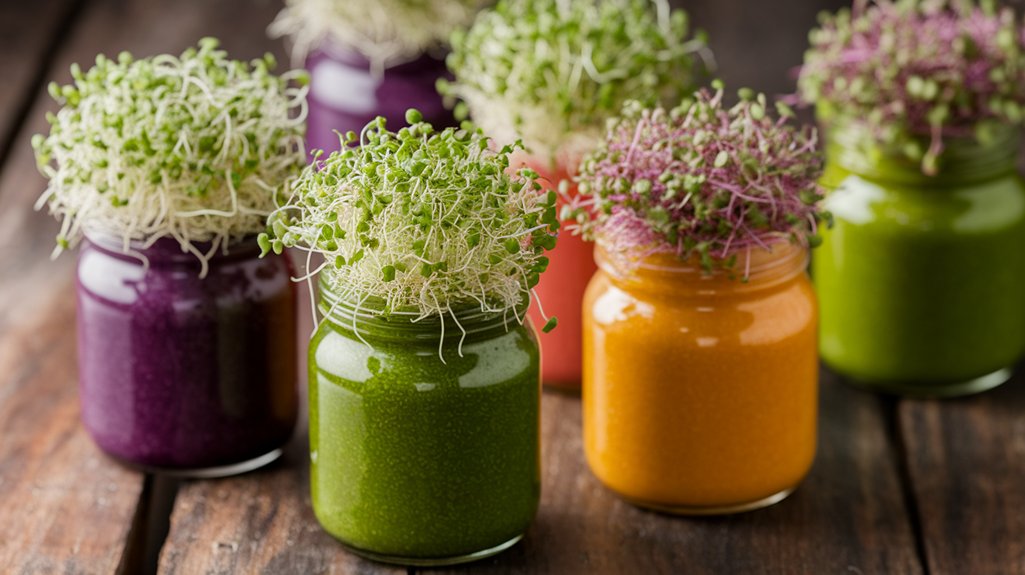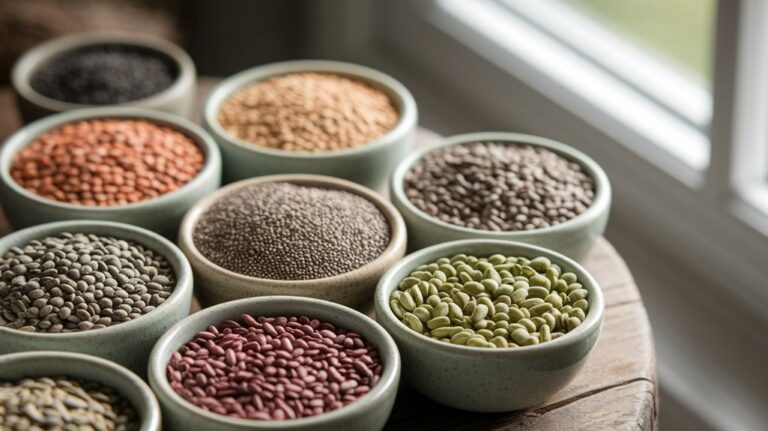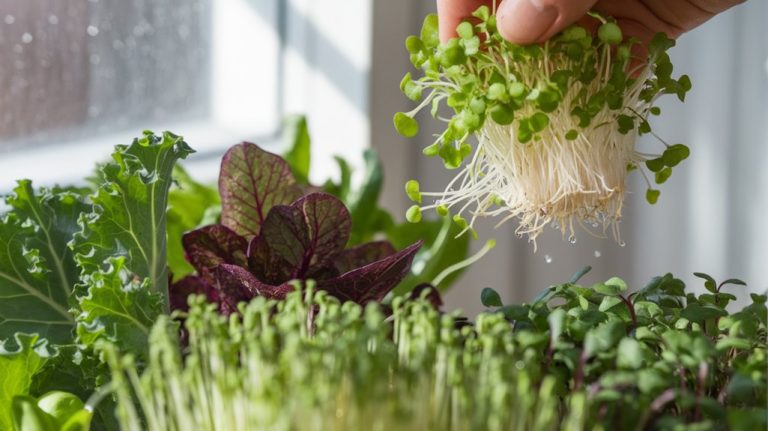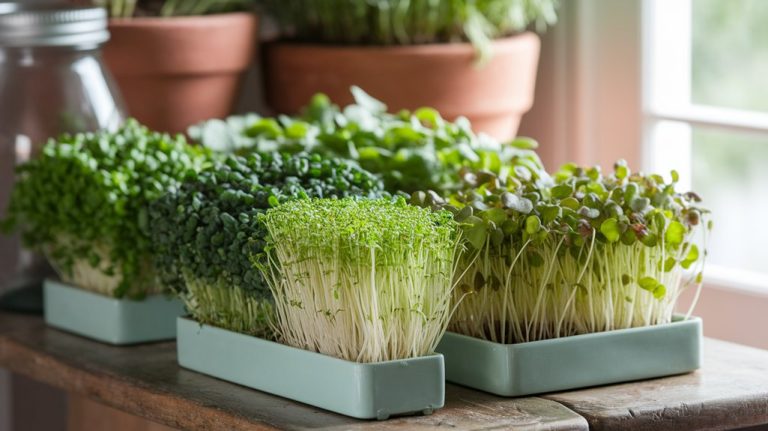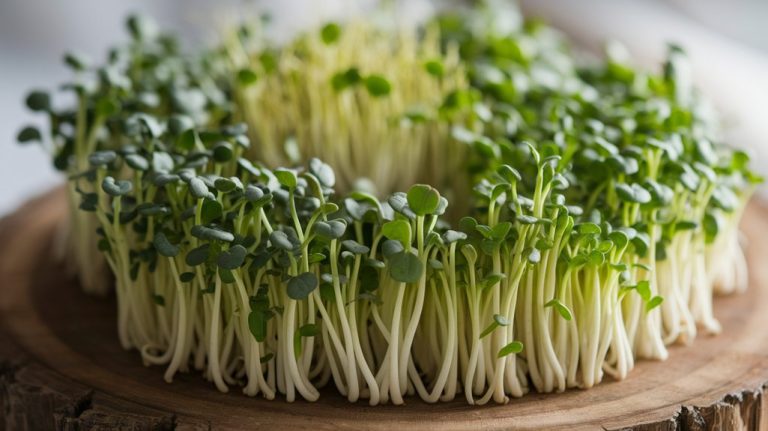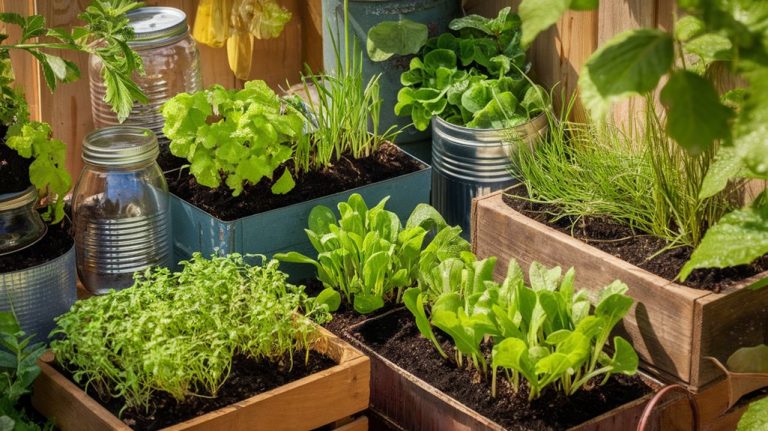Smoothie Supercharge: Adding Sprouts and Microgreens for Nutrient Density
If you want to supercharge your smoothies, adding sprouts and microgreens is a game changer. Sprouts are packed with vitamins and enzymes, while microgreens can contain up to 40 times more nutrients than mature plants. They not only enrich your drink with essential vitamins and minerals but also enhance flavor and texture. By choosing the right varieties, I can create delicious, nutrient-dense smoothies that boost energy and wellness. There’s much more to explore about incorporating these superfoods!
Key Takeaways
- Incorporate sprouts and microgreens into smoothies to significantly enhance nutrient density and boost health benefits.
- Microgreens can provide up to 40 times more nutrients than mature plants, enriching your smoothie’s profile.
- Balance flavors by pairing peppery microgreens like arugula with sweeter fruits for a delicious smoothie experience.
- Keep sprouts and microgreens visible in your kitchen to encourage regular incorporation into your smoothie routine.
- Experiment with different varieties, as colorful microgreens not only enhance nutrition but also improve visual appeal.
Understanding Sprouts and Microgreens: What Sets Them Apart

What really distinguishes sprouts from microgreens? I’ve learned that the key difference lies in their growth stages and cultivation methods.
Sprouts are germinated seeds, typically harvested within a few days, just after the seeds begin to sprout. They’re grown in water, requiring minimal light.
Microgreens, on the other hand, are young plants that are harvested later, usually between 7 to 21 days after germination. They require soil or a growing medium and more light to develop their leaves.
This difference in growth time and conditions affects their flavor, texture, and appearance. Understanding these distinctions helps me choose the right ingredient for my smoothies, ensuring I get the desired taste and texture in my drink.
Nutritional Benefits of Sprouts in Smoothies
Although I often focus on the taste of my smoothies, I can’t overlook the impressive nutritional benefits that sprouts bring to the table.
Sprouts are packed with vitamins, minerals, and antioxidants, making them a powerhouse addition. For instance, they’re rich in vitamin C, which boosts the immune system, and vitamin K, essential for bone health. They also contain fiber, promoting digestive health and keeping me feeling full longer.
Additionally, sprouts are low in calories, making them a guilt-free way to enhance my smoothies. With their unique enzymes, they can aid in digestion and nutrient absorption, too.
The Power of Microgreens: A Nutrient-Dense Addition
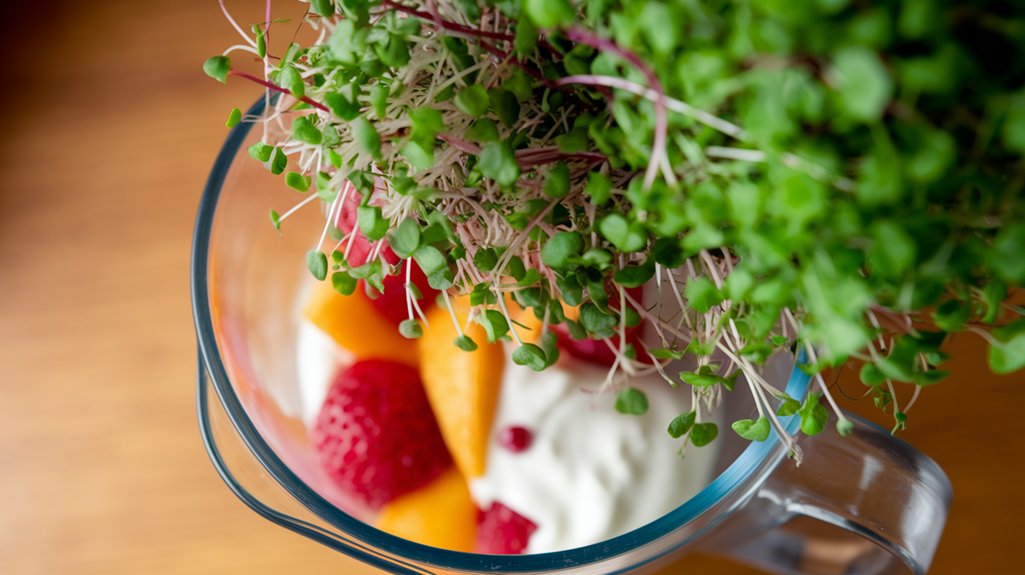
While I blend my smoothies, I often reach for microgreens, knowing they pack a serious nutritional punch. These tiny greens aren’t just cute; they’re loaded with vitamins, minerals, and antioxidants.
Research shows that microgreens can contain up to 40 times more nutrients than their mature counterparts. For instance, varieties like broccoli, kale, and radish are rich in vitamins C, E, and K, which support immune function and skin health.
Adding just a handful of microgreens enhances my smoothie’s nutrient profile without significantly altering the taste. Additionally, their concentrated nutrients can help boost energy and promote overall wellness.
Incorporating microgreens is a simple yet effective way to supercharge my smoothies and support my health goals.
Flavor and Texture: Enhancing Your Smoothie Experience
To elevate the flavor and texture of my smoothies, I’ve discovered that the right combination of ingredients can make all the difference. For instance, I love using a mix of fruits, vegetables, and healthy fats. Each component adds unique elements, creating a more satisfying drink. Here’s a quick reference table to guide you in choosing your ingredients:
| Flavor Profile | Texture Enhancer | Nutritional Boost |
|---|---|---|
| Berries | Chia seeds | Spinach |
| Mango | Avocado | Kale |
| Pineapple | Coconut milk | Flaxseeds |
| Banana | Greek yogurt | Almonds |
How to Choose the Right Sprouts and Microgreens
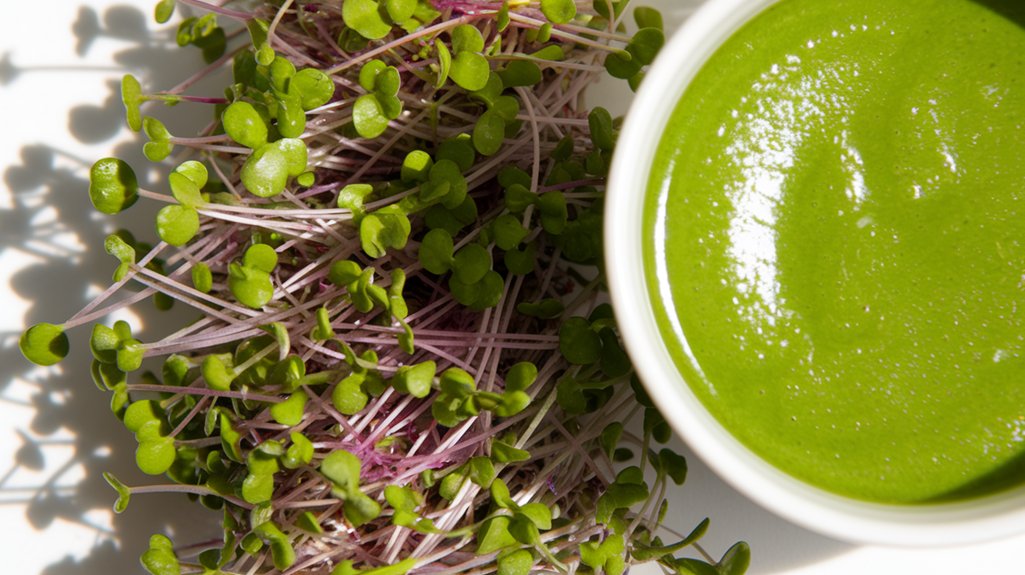
When I choose sprouts and microgreens for my smoothies, I always start by comparing their nutrient profiles.
Each type offers different vitamins and minerals that can enhance my drink’s health benefits.
I also consider how their unique flavors and textures will balance with the other ingredients for a satisfying blend.
Nutrient Profiles Comparison
Choosing the right sprouts and microgreens can feel overwhelming given the vast array of options available. To simplify, I focus on their nutrient profiles.
For instance, broccoli sprouts are packed with sulforaphane, a compound known for its cancer-fighting properties. On the other hand, alfalfa sprouts are rich in vitamins A, C, and K, supporting immune health and bone density.
If you’re looking for a source of omega-3 fatty acids, consider chia microgreens. They’re not just nutrient-dense; they also offer healthy fats.
When selecting, I always check for specific nutrients that align with my health goals. This targeted approach ensures I’m maximizing the benefits of my smoothies while enjoying a variety of flavors and textures.
Flavor and Texture Balance
Understanding the nutrient profiles of sprouts and microgreens is just the starting point; flavor and texture play a significant role in smoothie creation as well. Choosing the right combination can elevate your smoothie experience.
Here are four tips to balance flavor and texture:
- Peppery vs. Sweet: Use arugula or radish sprouts for a peppery kick, while sweeter options like pea shoots can create harmony.
- Crunch vs. Creaminess: Combine crunchy microgreens, like sunflower, with creamy ingredients such as banana or avocado for contrast.
- Earthy vs. Fresh: Pair earthy sprouts like lentils with fresh herbs, enhancing complexity.
- Color Appeal: Incorporate colorful microgreens like red amaranth for visual interest and added flavor depth.
Experimenting with these elements will help you achieve a delightful smoothie balance.
Creative Smoothie Recipes Featuring Sprouts and Microgreens
Incorporating sprouts and microgreens into smoothies can elevate your nutrient intake and flavor profile. One of my favorite recipes is a green powerhouse smoothie, blending spinach microgreens, banana, almond milk, and a scoop of plant-based protein. The microgreens add a fresh, earthy taste while boosting vitamins A, C, and K.
Another delightful option is a tropical treat with radish sprouts, mango, coconut water, and a squeeze of lime. The radish sprouts lend a peppery kick that complements the sweetness of the mango.
For a hearty smoothie, I recommend mixing sunflower sprouts, oats, blueberries, and Greek yogurt. This combo not only satisfies my hunger but also provides a rich source of antioxidants and healthy fats.
Give these recipes a try and enjoy the benefits!
Tips for Incorporating Sprouts and Microgreens Into Your Daily Routine
When I want to make sprouts and microgreens a regular part of my diet, I find it helpful to keep them visible and accessible in my kitchen.
Here are some tips that work for me:
- Add to Smoothies: Toss a handful into your morning smoothie for a nutrient boost.
- Use as Toppings: Sprinkle them on salads, soups, or sandwiches to enhance flavor and nutrition.
- Mix into Dishes: Incorporate sprouts into stir-fries, omelets, or grain bowls for added texture.
- Create a Routine: Set a reminder to include them in meals several times a week, making it a habit.
Frequently Asked Questions
Can Sprouts and Microgreens Be Grown at Home for Smoothies?
Absolutely, I’ve grown sprouts and microgreens at home, and it’s easier than you might think.
You can use simple materials like jars or trays and soil or just water. I usually start with seeds like alfalfa or radish, which germinate quickly.
In just a week or two, I’ve got fresh, nutrient-packed greens ready for my smoothies. Plus, it’s a fun and rewarding way to boost my nutrition right from my kitchen!
How Long Do Sprouts and Microgreens Last in the Refrigerator?
I’ve found that sprouts and microgreens can last about 5 to 7 days in the refrigerator when stored properly.
I always keep them in a breathable container, like a paper bag or a container with holes, to maintain airflow. If they start to wilt or smell off, I toss them out.
To enjoy their freshness, I try to use them within the first few days after purchase or harvest.
Are There Any Potential Allergies to Consider With Sprouts or Microgreens?
When it comes to sprouts and microgreens, I’ve learned that potential allergies can vary.
Some people might react to specific types, like soy or alfalfa sprouts, especially if they’ve existing legume allergies.
It’s essential to introduce them slowly into your diet and watch for any adverse reactions.
I always recommend consulting a healthcare professional if you have concerns about allergies.
Staying informed helps ensure a safe and enjoyable experience with these nutritious additions!
Can Smoothies With Sprouts and Microgreens Be Frozen for Later Use?
I often freeze my smoothies for convenience, but it’s important to know how sprouts and microgreens react.
Freezing can alter their texture and taste, sometimes making them mushy. While the nutrients generally remain intact, I suggest blending them fresh whenever possible for the best flavor and texture.
If you do freeze, use airtight containers and consume them within a month to maintain the quality.
It’s all about enjoying the healthiest option!
What Is the Best Time of Day to Consume Smoothies With Sprouts?
I’ve found that the best time to consume smoothies is in the morning, as they provide a quick and nutritious start to my day.
This timing helps me kickstart my metabolism and fuels my energy levels. If I’m looking for a midday boost, I’ll have one as a snack to keep my energy steady.
Ultimately, it depends on your routine, but I enjoy starting my day with a vibrant, nutrient-packed smoothie.
Conclusion
Incorporating sprouts and microgreens into your smoothies can significantly boost their nutrient density and enhance flavor. With their rich vitamins, minerals, and antioxidants, these tiny powerhouses offer a simple way to elevate your health. As you experiment with different varieties and recipes, you’ll discover a world of taste and nutrition waiting to be explored. So, grab your blender, get creative, and start supercharging your smoothies today! Your body will thank you.

